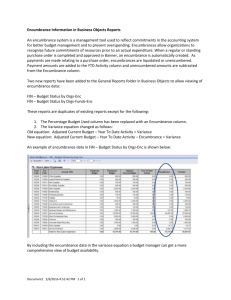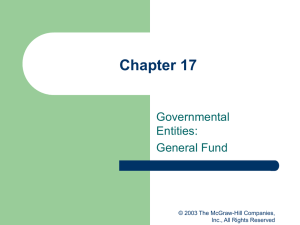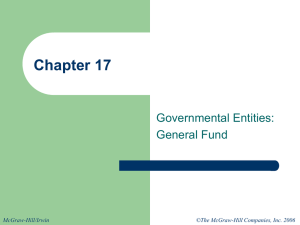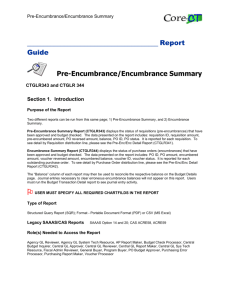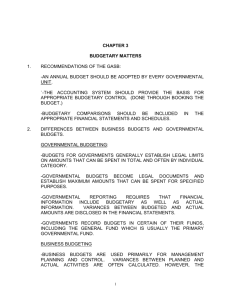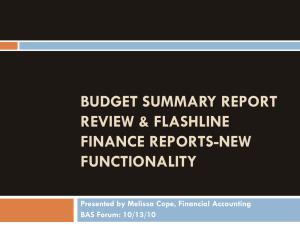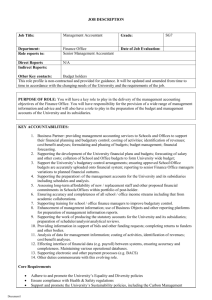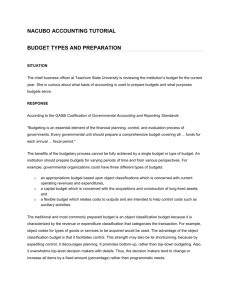ch3 - Cal State LA - Instructional Web Server
advertisement
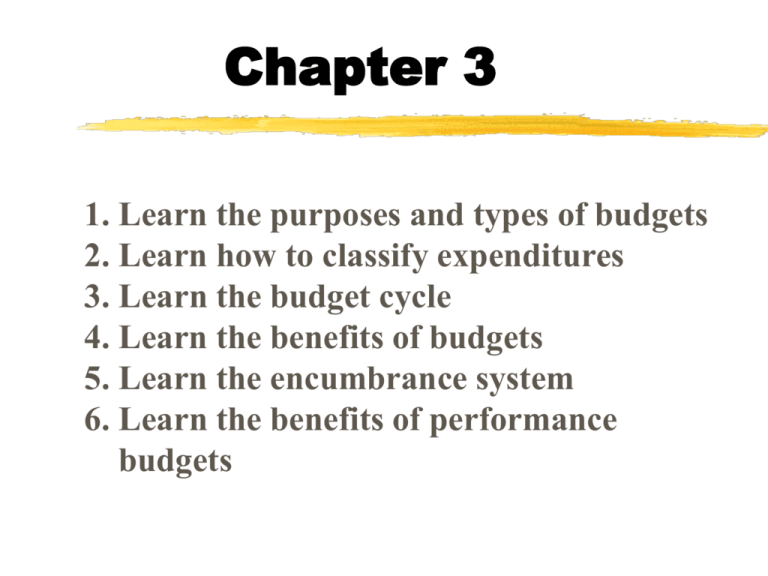
Chapter 3 1. Learn the purposes and types of budgets 2. Learn how to classify expenditures 3. Learn the budget cycle 4. Learn the benefits of budgets 5. Learn the encumbrance system 6. Learn the benefits of performance budgets Accounting Cycle • Record the budget • Encumber orders for goods and services • When good/services received • Reverse encumbrance • Recognize Expenditure • Record Revenue when measurable and available • Record transfers in and out • Record other financing sources and uses Accounting Cycle, continued • Close encumbrances at end of year • Adjusting entries • 60 day rule • Create reserve for supplies and other prepaids • Reverse budgetary entry • Close actual accounts • Debit revenue, OFS, transfers in • Credit expenditures, OFU, transfers out Purposes of Budgets • Planning of programs, acquisitions, resource allocations • Control and administration • Creating reports and evaluation Types of Budgets • Appropriation Budgets - details for current operations (this will be our main focus) • Capital Budgets- for acquisition and construction of long term assets • Flexible Budgets - relates to costs for certain levels of outputs, used to control costs in proprietary funds Object vs. Program Object classification is what you are used to…. Salaries, supplies, etc. This doesn’t allow for analysis of programs But does foster control of overall expenditures Uses bottom up budgeting…why is this good? Produces lots of detail Program budgeting allows analysis of programs using program specific inputs and outputs, or SEA Budget Cycle • Preparation • Legislative adoption and Executive approval • Execution • Reporting and Auditing Recording the Budget Record the revenue side of the budget: Estimated Revenues 1,000,000 Budgetary Fund Balance 1,000,000 Transfers in 25,000 Estimated Other Fin.Sources 500,000 Budgetary Fund Balance 525,000 Recording the budget serves as an internal control Recording Appropriations Budgetary Fund Balance 1,400,000 Appropriations 1,300,000 Other Fin. Uses 50,000 Transfers Out 50,000 If the inflows > outflows, then there is a budget surplus. If the inflows < outflows, there is a budget deficit. Closing Budget entries At the end of the fiscal year, the budgetary entries are reversed. Budgetary Fund Balance 1,525,000 Estimated Revenue 1,000,000 OFS 500,000 Transfers in 25,000 Appropriations 1,300,000 Estimated OFU 50,000 Transfers Out 50,000 Budgetary Fund Balance 1,400,000 Execution • Appropriations are apportioned by time periods in allocations (to agencies) then by allotment to units within the agency. • Entities, agencies integrate their budgets into their accounts. • Most agencies make sure they spend their budgets even if they stock up on supplies to insure that in the next year their budgets won’t be cut. Analysis Budget to Actual If an entity records a budget, part of their end of year statements includes a budget-toactual comparisons. Use caution in assessing this because: • Budgets might have been revised • Differences in Basis • Differences in timing • Differences in reporting level (Perspective) • Differences in reporting entity Encumbrance system Steps in the order/receipt process: • Purchase Request • Purchase Order • Receiving Report • Vendor’s Invoice Paid Purchase Order Encumbrances 950 Reserve for Encumbrances 950 This creates a reserve in the fund balance section of the balance sheet, so Fund Equity = Assigned + Fund Balance Receipt of Order Two Parts: Reverse the reserve for encumbrances: Reserve for Encumbrances 950 Encumbrances 950 Record the receipt of the shipment: Expenditures 970 Vouchers Payable 970 Notice that the encumbrance is reversed for its original amount, not the amount of the bill Payment of Voucher Voucher Payable Cash Expenditures 970 The entity took a discount! 965 5 Open Encumbrances What was shown on the previous slides assumes that orders are received within the same year and all at once. What happens if an encumbrances is still open at the end of the fiscal year? What happens if a partial order is received? Open encumbrances Think about the accounts you used to establish an encumbrance: Encumbrance Reserve for encumbrance The government wants to show the reserve in the fund balance section of the balance sheet, but is encumbrance an asset? Should it be closed with expenditures? Encumbrances is like a notation, but is not a permanent account. Therefore, if an encumbrance is open at the end of the year, it needs to be closed. Closing an encumbrance Assume you have established an encumbrance: Encumbrance 5,000 Reserve for Encumbrance 5,000 And some of the order is received: Reserve for encumbrance Encumbrance Expenditure Vouchers Payable 2,500 2,500 2,500 2,500 There is still $2,500 in an encumbrance open at the end of the fiscal year. It needs to be closed. Encumbrances, FY 2 First, reestablish the encumbrance in FY 2: Encumbrance 2,500 Unreserved Fund balance 2,500 Then complete the process as already illustrated: When the order is received: Reserve for encumbrance Encumbrance Expenditure Vouchers payable 2,500 2,500 2,500 2,500 Closing an encumbrance Close the remaining amount at the end of the fiscal year: Unreserved fund balance 2,500 Encumbrance 2,500 But what happens when the rest of the order comes in? Review Why governments record budgets How to record the budget How to record encumbrances
